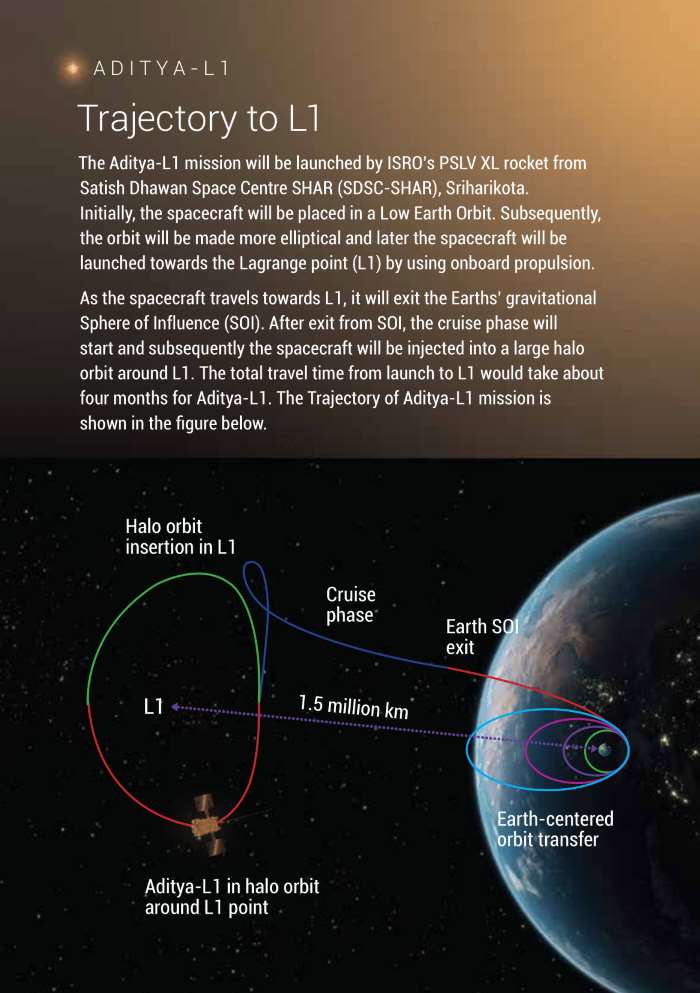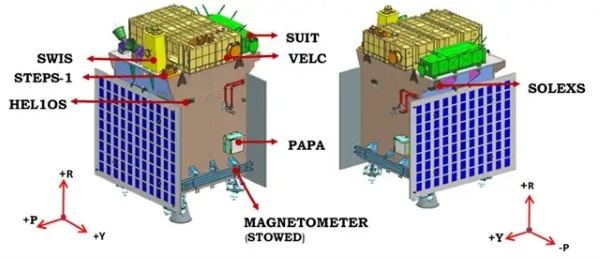Aditya L1 is India’s first solar mission that carries the objective to study the sun. This mission will determine the sun’s effects on the Earth and its atmosphere in real-time. ISRO mentions: “This will provide a greater advantage of observing the solar activities and its effect on space weather in real time.”
Some highlights of India’s new solar mission are:
|
This mission will be a major step forward for India's space program. It is the first Indian mission to study the Sun in detail, and it will provide valuable information about the Sun's impact on Earth.
Aditya L-1 Mission: Live Updates
Aditya L-1 took its flight from Satish Dhawan Space Centre (SDSC) SHAR, Sriharikota.
After historic moon landing, ISRO’s maiden solar mission, Aditya- L1, launched successfully from Sriharikota
— ANI Digital (@ani_digital) September 2, 2023
Read @ANI Story | https://t.co/LQ0TiEujby#AdityaL1Launch #ISRO_ADITYA_L1 #Sriharikota pic.twitter.com/dn4yvI5QJh
Everything is on track
The Aditya L1 mission is off to a good start. The vehicle is performing normally and has successfully separated from the second and third stages of the PSLV rocket. Mission control is reporting that everything is working as intended.
PSLV rocket in coasting phase after third stage separation
The third stage of the PSLV rocket has successfully separated from the rocket. It is now in the PS4 coasting phase, which is a period of free flight before the fourth stage ignites.
G Madhavan Nair on Aditya L1
Former Indian Space Research Organisation (ISRO) chairman G Madhavan Nair said that data from the Aditya L1 mission will help explain various celestial phenomena taking place in the Sun's atmosphere and aid climate change studies.
Key objectives of the Aditya L1 mission
The Aditya L1 spacecraft is currently in the coasting phase, which is a period of free flight before it reaches its final destination, the Sun-Earth Lagrange point L1. During this phase, the spacecraft will be gathering data to help it achieve its key objectives, which are to:
- Examine coronal mass ejections (CMEs), which are large expulsions of plasma and magnetic fields from the Sun's corona.
- Study the corona's magnetic field, which is responsible for the heating and dynamics of the corona.
- Study the chromosphere, which is the layer of the Sun's atmosphere just below the corona.
- Study the movement of particles from the Sun, including solar wind and energetic particles.
- Understand why the Sun's atmosphere, the corona, is hotter than its surface.
India's first space-based solar observatory
The Aditya L1 mission is a first for India. It is the first space-based observatory to study the Sun. The spacecraft will travel about 1.5 million kilometers from Earth over 125 days and then be placed in a halo orbit around the Lagrangian point L1, a stable spot close to the Sun.
Why India is studying the Sun
India is studying the Sun because it wants to understand the Sun's activity and its impact on the Earth. The Sun is a very dynamic star, and it is constantly changing. These changes can cause solar flares, coronal mass ejections, and other solar events that can have a significant impact on the Earth's atmosphere and climate.
Aditya L1 to probe the Sun's corona
Annapurni Subramaniam, director of the Indian Institute of Astrophysics, said that the Aditya L1 mission will be the first to probe into the innermost part of the Sun, the corona. "We have boarded the main instrument on board the launch vehicle carrying Aditya L1. It is the Visible Line Emission Coronagraph (VELC). It will enable an unobstructed view of the Sun."
PS4 second burn begins
The second burn of the PS4 stage has begun, confirmed ISRO's range operations director. The burn is expected to last for about 10 minutes, and it will help to place the Aditya L1 spacecraft into a higher orbit.
Aditya L1 spacecraft enters Earth-bound orbit
The Aditya L1 spacecraft is now in an eccentric Earth-bound orbit. All signals are healthy, and the spacecraft is expected to enter the first of many Earth orbits before it heads to its designated L1 point.
Aditya L1 spacecraft successfully separates from PSLV rocket
The Aditya L1 spacecraft has successfully separated from the upper stage of the PSLV rocket. This is a major milestone for the Aditya L1 mission, and it brings the spacecraft one step closer to its final destination, the Sun-Earth Lagrange point L1.
Aditya L1 spacecraft to undergo first Earth-bound firing tomorrow
The Aditya L1 spacecraft is scheduled to undergo its first Earth-bound firing tomorrow. This firing will be used to increase the spacecraft's velocity and altitude, which will put it on course to reach L-1 point.
What Is The Launch Date and Time of the Aditya L1 Solar Mission?
| Mission Name | Aditya L-1 |
| Aditya L1 Mission Launch Date | 2 September, 2023 |
| Aditya L1 Mission Launch Time | 11:50 AM |
| Aditya L1 Mission Landing Site | Lagrangian Point 1 |
| Type of Mission | Solar mission |
The launch date of the Aditya L-1 mission is September 2, 2023, at 11:50 A.M IST. The mission is scheduled to be launched by the Indian Space Research Organisation (ISRO) from the Satish Dhawan Space Centre in Sriharikota.
🚀PSLV-C57/🛰️Aditya-L1 Mission:
— ISRO (@isro) August 28, 2023
The launch of Aditya-L1,
the first space-based Indian observatory to study the Sun ☀️, is scheduled for
🗓️September 2, 2023, at
🕛11:50 Hrs. IST from Sriharikota.
Citizens are invited to witness the launch from the Launch View Gallery at… pic.twitter.com/bjhM5mZNrx
The launch of the Aditya L-1 mission has been delayed several times due to technical reasons. The original launch date was 2020, but it was later pushed back to 2021, and then to 2022. The launch was further delayed to 2023 due to the COVID-19 pandemic.
ISRO is confident that the Aditya L-1 mission will be launched on September 2, 2023. The spacecraft is ready for launch, and the ground systems are being tested. The launch team is confident that they will be able to successfully launch the Aditya L-1 mission.
Where to Watch Aditya L-1 Mission Launch Live?
ISRO has officially begun the countdown of the Aditya L-1 Mission on 1 September 2023 at 12:10 P.M. IST. The space organisation announced the countdown through its Twitter account.
PSLV-C57/Aditya-L1 Mission:
— ISRO (@isro) September 1, 2023
The 23-hour 40-minute countdown leading to the launch at 11:50 Hrs. IST on September 2, 2023, has commended today at 12:10 Hrs.
The launch can be watched LIVE
on ISRO Website https://t.co/osrHMk7MZL
Facebook https://t.co/zugXQAYy1y
YouTube…
Aditya L-1 Mission can be viewed on ISRO's website, Facebook page, YouTube channel and on DD national TV channel. the live broadcast will begin from 11:20 A.M IST
What Is L-1 in Aditya Mission?
L1 is a gravitationally stable point located between the Sun and Earth. It is about 1.5 million kilometres from Earth, and it is the point where the gravitational pull of the Sun and Earth are equal. This means that a spacecraft placed in L1 will stay in a fixed position relative to both the Sun and Earth.

Source: Twitter (ISRO)
The L1 point is a good location for studying the Sun because it is relatively close to Earth, so the spacecraft can transmit data back to Earth quickly. It is also a good location for studying the Sun because it is not affected by the Earth's atmosphere, which can block out some of the Sun's radiation.
What Is the Budget of Aditya L-1 Mission?
The Aditya L1 mission is a big project by the Indian Space Research Organisation (ISRO). It will study the Sun's corona, the outermost layer of the Sun's atmosphere. The budget for the mission is about 400 Crore (around US$50 million) according to the India Times and the Hindustan Times. This money will be used to design, develop, launch, and operate the spacecraft. It will also be used to buy the instruments and equipment needed to study the Sun's corona.
The budget for the Aditya L1 mission is a lot of money, but it is necessary for such a complex project. The mission will help India to better understand the Sun and its impact on Earth. It will also help India to contribute to global scientific progress.
What Are the Payloads of Aditya L-1?

Source: ISRO
According to ISRO, there are seven payloads of Aditya L-1 Mission which are divided into two categories: Remote Sensing Payloads and In-situ Payloads. The payloads are:
| Type | Sl. No. | Payload | Capability |
| Remote Sensing Payloads | 1 | Visible Emission Line Coronagraph(VELC) | Corona/Imaging & Spectroscopy |
| 2 | Solar Ultraviolet Imaging Telescope (SUIT) | Photosphere and Chromosphere Imaging- Narrow & Broadband | |
| 3 | Solar Low Energy X-ray Spectrometer (SoLEXS) | Soft X-ray spectrometer: Sun-as-a-star observation | |
| 4 | High Energy L1 Orbiting X-ray Spectrometer (HEL1OS) | Hard X-ray spectrometer: Sun-as-a-star observation | |
| In-situ Payloads | 5 | Aditya Solar Wind Particle Experiment(ASPEX) | Solar wind/Particle Analyzer Protons & Heavier Ions with directions |
| 6 | Plasma Analyser Package For Aditya (PAPA) | Solar wind/Particle Analyzer Electrons & heavier Ions with directions | |
| 7 | Advanced Tri-axial High-Resolution Digital Magnetometers | In-situ magnetic field (Bx, By and Bz). |
Source: ISRO
What Are the Objectives of Aditya L-1 Mission?
The Aditya L1 mission has 9 major science objectives:
|
These objectives are important because they will help us to better understand the Sun and its impact on Earth. The Sun is the source of all life on Earth, and it also plays a role in space weather, which can disrupt our technology and infrastructure. By understanding the Sun better, we can better protect ourselves from its harmful effects.
How Will Aditya L-1 Work?
The Aditya L1 mission will be launched by the Indian Space Research Organisation (ISRO) using the PSLV-C57 rocket. The PSLV-C57 is a four-stage rocket that is capable of placing a 1,750-kilogram payload into low Earth orbit.
After the Aditya L1 spacecraft is launched, it will first be placed in a low Earth orbit. The orbit will be made more elliptical using the spacecraft's onboard propulsion system. The spacecraft will then use its propulsion system to launch itself towards the L1 point.
As the Aditya L1 spacecraft moves towards the L1 point, it will exit Earth's gravitational sphere of influence (SOI). The SOI is the region of space around a planet where the planet's gravity is stronger than the gravity of any other body. When the Aditya L1 spacecraft exits Earth's SOI, it will be in orbit around the Sun, but it will also be balanced by the gravitational pull of Earth.
The Aditya L1 spacecraft will arrive at the L1 point about 20 days after launch. Once it arrives at the L1 point, it will stay there for five years.
ISRO is excited about the Aditya L-1 mission. They believe that the mission will make significant contributions to our understanding of the Sun and its impact on Earth. They are also confident that the mission will be a success after the victorious landing on the moon through the Chandrayaan-3 mission.
Comments
All Comments (0)
Join the conversation